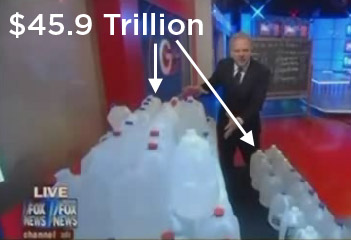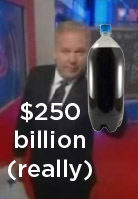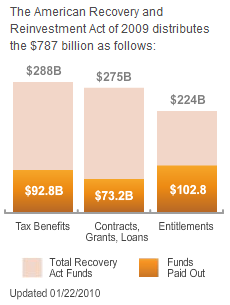Back in 2009 I made a visualization about the deficits we were expecting under President Barack Obama. I called it the “National Debt Road Trip” and it was moderately popular.
Today, after nearly 3 years, I have updated it with a new video:
The video itself is just an overview of data that I’ve been toying around with for a month or so. I’ll do an in depth look at the data first and then answer some questions close observers might have about the data.
The National Debt Road Trip Details
The debt data has been collected from Treasury Direct website and adjusted for inflation using the Bureau of Labor Statistics CPI data. For the future debt, I used the debt projection for 2016 from President Obama’s 2013 budget (Historical Tables, Table 7.1 – Federal Debt at the End of the Year).
For the presidents where I had daily debt data (from 1993 – present), I used “inauguration-to-inauguration” debt numbers.
When I didn’t have those (for Ronald Reagan & George H W Bush) I used the yearly debt numbers including the fiscal year for which they were responsible. So for Reagan I used October 1981-October 1989 and for HW Bush I used October 1989 to Jan 20, 1993 (when daily data became available).
With all this information, I came up w/ the following data points (adjusted for inflation)
Ronald Reagan debt
from $2.29 trillion to $4.82 trillion
$2.53 trillion increase over 8 years
$316 billion / year
George H W Bush debt
from $4.82 trillion to $6.54 trillion
$1.72 trillion increase over 4 years
$430 billion / year
Bill Clinton debt
from $6.54 trillion to $7.38 trillion
$0.84 trillion increase over 8 years
$105 billion / year
George W Bush debt
from $7.38 trillion to $11.17 trillion
$3.79 trillion increase over 8 years
$474 billion / year
Barack Obama (measured) debt
from $11.17 trillion to $15.57 trillion (March 21)
$4.40 trillion increase over 3 years, 2 months
$1,390 billion / year
Barack Obama (future projection) debt
from $15.57 trillion to $20.39 trillion
$4.7 trillion increase over 4 years, 10 months
$995 billion / year
It was then a simple matter to apply the $5.8 billion-per-mile, 1 hour-per-year calculation to get what you see in the video.
What I Assume Will Be Frequently Asked Questions
Q: I ran your numbers and you’re wrong! Bush increased the debt by $4.9 trillion, not $3.8 trillion.
A: Did you adjust for inflation? (Hint: No, you did not.)
Q: Why are your numbers different here than they were in your original video?
A: Back in 2009, I was new to researching federal financial data. I used a different, less accurate method of inflation calculation for my first video. Additionally, the inflation data of the last 3 years ended up altering where George W. Bush “stopped” in debt accrual. Finally, I tried to be all fancy in my calculations last time, making estimations to calculate debt between fiscal years. I didn’t do that this time so, while the numbers are in the same ballpark as the first video, I believe them to be a more accurate representation.
Q: You said “during the first 38 months of his presidency” but you crossed out 39 months. Why?
A: Good eye. At that point in the video I was disregarding debt accrued from January 20, 2009 to March 21, 2012. That is almost exactly a 38 month period, but I crossed out two partial months (January 2009 and March 2012) for the sake of simplicity.
Q: Why use “inauguration-to-inauguration” data instead of “fiscal-year-to-fiscal-year”? In short, why did you assign President Obama the debt from 2009? That was a budget Bush signed, he should be blamed for the debt.
A: Normally, I would agree on this count. However, President Obama’s stimulus deeply complicates the matter. Federal spending for 2009 was drastically higher than the budget that was passed due to the Obama stimulus. Add to that the sizable tax credits from the stimulus and we see President Obama’s policies have significant effect on both the revenue and the spending side. I felt that doing calculations based on assumptions of what could have happened would be presumptuous and call the data into question. So instead I tried to use numbers that could be easily fact-checked.
Q: I have a chart here that *proves* George W. Bush is responsible for all this debt. Why do you hate the truth?
A: That’s less of a question and more of a pout, but here is my position: I’ve seen that chart and I’m of two minds about it. On the one hand, yes, Bush implemented a lot of policies that racked up a lot of debt. On the other hand, Obama has been in office an awful long time to not be held accountable for the state of federal finances. That is why I separated out “before” and “after” into two different speeds.
I think it is a totally valid question to ask “Now that the economy has turned around why haven’t federal finances?” Is Barack Obama the only president in the history of ever to not be held responsible for anything that happened during his presidency? It seems rather insulting to President Obama to imply he is so ineffectual that, even after 3+ years in office, he is merely a figurehead doll swept along the current of a river he cannot control. (Worst. Metaphor. Ever.)
Q: Why didn’t you use debt as a % of GDP?
A: A couple reasons. The first is that doing so really complicates the metaphor I’m using. Secondly, it would actually put President Obama at a disadvantage because debt as a % of GDP spiked drastically in his first year since not only did the debt increase, but the GDP decreased increasing the number from the numerator and the denominator side of the ratio. Thirdly, while the president doesn’t have total control over the deficit, he has far more control over it than over GDP increases or decreases. Using “debt as a % of GDP” is a less direct measurement of presidential responsibility.
Q: What do you mean by “optimistic revenue estimates”?
A: According to President Obama’s own budget, he expects 2014 revenue to be 43% higher than 2011 revenue. The only time in modern fiscal history that this has happened was when inflation was in the double digits, so the increase in revenue wasn’t a real increase. He’s already way off target for his 2012 revenue estimates, so I don’t think it’s a stretch to say these are “optimistic revenue estimates”.
In my video I wanted to give President Obama the benefit of the doubt. I wanted to say “Even though I think you’re being overly optimistic, we will use your numbers as an act of good faith.” The horrifying thing is that, even with President Obama’s extreme optimism on the revenue side of the equation, he still projects monster deficits long into the future.
The big point here is that President Obama has no plan to deal with deficits or debt. He’s kinda-sorta hoping that we’ll start making enough revenue to catch up to the spending increases, but he kinda-sorta knows that isn’t going to happen. Yet he has made no moves to reduce spending to match (or even come within screaming distance of) federal revenues.
And I think that is a problem.



